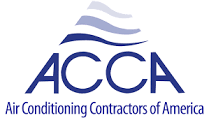My name is John Morris the owner of www.morrisheatandair.net and enterprise compressed gas. I have been designing and installing new duct systems for several years and have witnessed many pre-existing and new duct systems designed and installed incorrectly and seen a few installed correctly. In this blog, I want to express my deepest, most sincere, desire to assist you, the reader, to correctly answer questions by customers about design and installation of new duct systems. It is very important that you consider Morris Heat and Air for your new duct system installation because of our overall experience installing new duct systems and our affiliation and implementation of ACCA, BPI, and IECC Standards. ACCA, BPI, and IECC standards are the key to making your new duct system long lasting without any setbacks associated with the design.
Before I go get too involved about the importance of our methodology, I would like to invite you to consider Morris Heat and Air for your New Duct System Design and Installation. I know that our New Duct System installations are installed correctly and are sealed correctly. If you or someone you know has an old duct system that is falling apart or not evenly distributing the air throughout the home, please allow us to at least design your new duct system and hopefully install it too.
On several occasions every year, I am asked to relocate or add ducts to areas the homeowner feels should have a duct added. Many people in the HVAC Industry jump all over a customer’s request to do so, seeing it as a quick paycheck for a simple task. But hold on….. Can we, as professionals, just add a duct to an add on room for a customer? I say yes, but there are definitely some things to consider. First of all, when a duct system is installed, it is designed and installed according to the original design of the home. The first thing to consider when making modifications is the potential to disrupt the original design by attempting to incorporate the new design with the original. Sound confusing? Well it is. Anytime a homeowner asks me to make a duct modification, I first explain to the homeowner that we must have a blueprint to justify what we are doing. Then I ask the homeowner. Do you have a blueprint? Usually they say no. Then I explain to them that I can generate a blueprint for $250 and conduct an ACCA Manual J and an ACCA Manual D. Homeowners usually frown at the thought of paying just to generate a blueprint. But here is why. If I make a duct system modification and it is wrong, 9 times out of 10 the homeowner will blame me and either want their money back or expect me to fix it. So to ensure that the modification is done correctly, it is best to do an ACCA Load Calculation. Some homeowners will never see it my way and insist that I just add a duct to an add on room. If they persist, I ask them to simply draw up a blueprint of what they want done. I ask them to please make sure to include the size of the duct and from where they want it to stem from the existing duct system and what kind of material they want me to use. I have had problems with homeowners questioning my approach, but they always seem to see it my way eventually. Many attempt to do it themselves only to call upon me to determine why the home is not evenly heating and/or cooling.
In the end, requiring a blueprint to justify the modifications is a key step to protecting yourself of any liability in regards to modifying or installing a new duct system. If you try to install it without conducting a load calculation, I guarantee you are wrong. Unless, of course, it is a new addition and all the homes are orientated the same and constructed the same and an ACCA Manual J and ACCA Manual D was conducted on the first home.
I have participated with utility company programs for many years. One in particular that comes to mind is OG&E’s Home Energy Efficiency Program (HEEP). This program in particular is managed by CleaResults, an energy management company. Even though this program is a simple tune up program, it requires all contractors to determine the Total External Static Pressure (TESP) of every customer’s ducted system. To be a part of this program, you must first go through an entire day of training with one of their trainers like Rob Robertson. As a part of training, Rob Robertson includes a full course on how to correctly determine the TESP of a ducted system by taking the negative pressure after the filter and before the blower motor and taking the positive pressure after the blower motor and before the evaporator. When adding the two pressures together, as if they were both positive, you come up with the TESP. I am mentioning this program in particular because of the importance of this TESP. When I install a new duct system to ACCA Standards, I always check the TESP of the duct system after installation and upon start up. My newly installed duct systems usually test out at a .28 inch water column to a .41 inch water column. As a part of OG&E’s HEEP Program, every home I go to after cleaning the coils and changing the filters tests out at .69 inches water column to 1.3 inches water column! Manufacturers of residential furnaces usually list on their data plate that the TESP of the duct system should not exceed .5 inches water column. If you look within a manufacturer’s installation instructions, there is usually a blower performance chart that lists the varying levels of performance based upon the fan speed selection and the TESP. Every set of instructions I have ever seen indicates a low level of performance and increased wattage when your TESP rises above .5 inches water column. The main reason for mentioning TESP, is to make you aware of an evident problem that exists when your ducted system tests out at a level that exceeds .5 inches water column. If you test a duct system for TESP and it exceeds .5 inches water, it is recommended that you conduct an ACCA Manual J and an ACCA Manual D load calculation to generate a blue print to compare with the installed duct system. Once compared, you can easily determine what problems exist within the existing duct system. Usually a combination of undersized return and supply ducts and inadequate surface area of filter.
Air filtration is very important because it keeps your system clean and alleviates your air within your home of allergens and dust. Air filters become very problematic when they are installed on leaky duct systems and undersized. Air conditioners require 200 square inches of 1″ pleated filters per ton of cooling. All to often, I see a centralized return filter grill in the hallway of a home that is 14x24x1. A 14x24x1 filter is only 336 square inches. 336 square inches of 1″ media is barely enough for a 1 1/2 ton air conditioner. If your filters are undersized your duct system will pull more air from leaks in the return duct system and you will have to replace your filters more frequently. Undersized filters will also cause diminished performance of your heating and cooling equipment and cost you more money in energy to run your air conditioner and heater. A typical 3 ton air conditioner should have a minimum 600 square inches of 1″ media. That is equivalent to a 20x30x1 filter. I typically try to install 5″ media boxes such as Clean Comforts AM11-2025 or the AM11-2025-5RA for Right Angle applications in basements or upright attic installations. These filters are 20×25 which is 500 square inches, but they are 5 inches thick. This increases the surface area to 2500 square inches. The more surface area of filter you have, the less restrictive on the air flow which lowers your TESP which, in turn, increases your system’s performance. On top of all that, you change your filters less frequently. A 20x25x5 media filter by clean comfort on a 2 ton system may only need to be changed once every 12-24 months rather than once every 1-3 months. This costs you less on filters which saves you money.
Another efficiency program that I have been a part of is the Higher Performance Homes program offered by Public Service Company of Oklahoma or PSO. This program is managed by ICF International and incentivizes whole home remodels addressing areas of improvement such as duct system sealing and redesign/implementation, new higher efficient heating and cooling systems, reducing air infiltration rates on homes and installing insulation on knee walls, roof decks, walls, crawl spaces and attics. What I really like about this program is enforcement of blueprints when installing new duct systems. The most widely accepted method of blueprint generation is the ACCA Manual J and ACCA Manual D 8th Edition by Wrightsoft Suite. ICF International has ACCA trained specialists working for them like Rob George. Rob George is very knowledgeable about ACCA Standards of duct design and systems load calculation and a person can learn a lot by attending one of his workshops if he is ever in your area. Wrightsoft offers a vast number of workshops nationwide on duct design and load calculations. I attended a few 40 hour classes at Tulsa Technology Center in Tulsa Oklahoma for ACCA Manual J and ACCA Manual D. The teacher who I studied under was Dave Stephenson at the Lemley Campus. Aside from all the knowledge that exists, ACCA manuals are literal manuals that can be purchased from ACCA. You can purchase and read ACCA Manual J and ACCA Manual D.
I hope this has helped you to understand duct systems. I really get annoyed when people insist that I should make a duct modification at their request because they are paying me to do it. Worst case scenario is to insist that they draw up their own blueprint of what they want done, even if it is on a McDonald’s napkin. At least I have some blueprint to justify what I am doing. In the future, I would like to emphasize the importance of ensuring a sealed home with few air changes per hour as well as a sealed duct system with no leakage. I know the importance of a well designed duct system and also know that a well designed duct system is worthless without ensuring the duct system has less than 6 CFM leakage at 25 Pascals negative pressure duct blast. I also know that if a home exceeds more than 3 Air Changes per hour by volume that a perfectly sized and installed duct system will be worthless. In my next blog, I will emphasize the importance of following the IECC code requirements for duct leakage and home leakage as well as the BPI Standards pertaining to duct leakage and home leakage.
If you need a new duct system or have any questions please feel free to call, text or email me.
John Morris
(918) 734-0040
morrisheatandair@gmail.com


